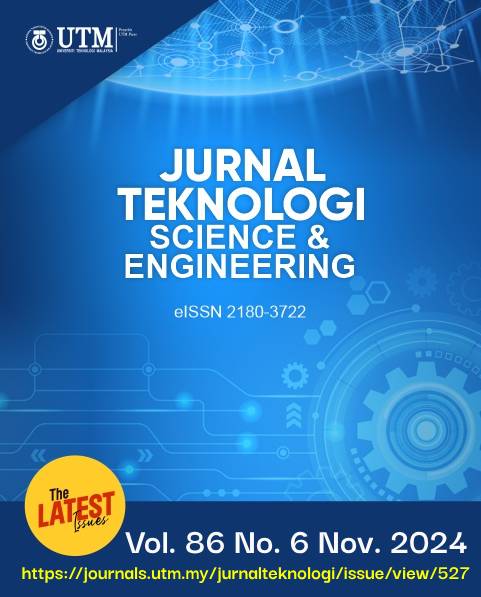DRAINAGE SYSTEM TRANSFORMATION TOWARDS EFFECTIVE FLOOD CONTROL WITH EPA SWMM
DOI:
https://doi.org/10.11113/jurnalteknologi.v86.22294Keywords:
Revetment, Hydrology, Hydraulics, Tides, Channel CapacityAbstract
The village of Kunjir often experiences floods caused by suboptimal drainage systems, land use changes, and revetment construction. The utilization of EPA SWMM proves to be an interesting solution to address flood issues. The research aims to analyze the drainage channel capacity using the EPA SWMM program, assess the tidal influence on the channels, and provide solutions to the existing problems. The method involves hydrological and hydraulic analysis using Microsoft Excel and the EPA SWMM program. Rainfall and topographic data are utilized to determine flood discharge, while existing channel data are used to calculate channel capacity. HWL values are used to analyze the tidal influence on the channels. The modeling process involves creating a network scheme and inputting data into the existing channels. The program is executed, and evaluations are conducted on problematic channels. Redesign planning is implemented by altering channel dimensions and re-running the simulations. The conclusion indicates that channels 2B, 2B1, 2B1 Left, 2C, and 2D cannot accommodate the flow discharge, tidal influence affects channel 1C, Box Culvert, and Downstream River, and solutions include enlarging channels, adding bottom slope to channels, regular maintenance, and installing floodgates to mitigate tidal effects.
References
Putra, M. A. R., Andawayanti, U. & Lufira, D. R. (2022). Studi Evaluasi dan Penanganan Genangan Menggunakan Aplikasi SWMM 5.1 pada Sistem Drainase Darmo Kali Kota Surabaya. Jurnal Teknologi dan Rekayasa Sumber Daya Air, 2(2), 128–141.
DOI: https://repository.ub.ac.id/id/eprint/190736/
Mugume, S. N., Gomez, D. E., Fu, G., Farmani, R., & Butler, D. (2015). A global analysis approach for investigating structural resilience in urban drainage systems. Water Research, 81, 15–26.
DOI: https://doi.org/10.1016/j.watres.2015.05.030
Sangsefidi, Y., Bagheri, K., Davani, H., & Merrifield, M. (2023). Data analysis and integrated modeling of compound flooding impacts on coastal drainage infrastructure under a changing climate. Journal of Hydrology, 616, 1–13.
DOI: https://doi.org/10.1016/j.jhydrol.2022.128823
Damilola, A. E. (2016). The Osun Drainage Basin in the Western Lithoral Hydrological Zone of Nigeria: A Morphometric Study. Malaysian Journal of Society and Space, 12(8), 71–88.
DOI: https://doi.org/10.17576/geo-2021-1701-01
Rosyidie, A. (2013). Banjir: Fakta dan Dampaknya, Serta Pengaruh dari Perubahan Guna Lahan. Jurnal Perencanaan Wilayah Dan Kota, 24(3), 241–249.
DOI: https://doi.org/10.5614/jpwk.2013.24.3.1
Qodriyatun, S. N. (2020). Bencana Banjir: Pengawasan dan Pengendalian Pemanfaatan Ruang Berdasarkan UU Penataan Ruang dan RUU Cipta Kerja. Aspirasi: Jurnal Masalah-Masalah Sosial, 11(1), 29–42.
DOI: 10.22212/aspirasi.v11i1.1590
Berggren, K., Olofsson, M., Viklander, M., Svensson, G., & Gustafsson, A.M. (2012). Hydraulic Impacts on Urban Drainage Systems Due to Changes in Rainfall Caused by Climatic Change. Journal of Hydrologic Engineering, 17(1), 92–98.
DOI: https://doi.org/10.1061/(asce)he.1943-5584.0000406
Wit, J. A. de, Huijgevoort, M. H. J. van, Dam, J. C. van, Eertwegh, G. A. P. H. van den, Deijl, D. van, Ritsema, C. J., & Bartholomeus, R. P. (2024). Hydrological consequences of controlled drainage with subirrigation. Journal of Hydrology, 628, 1–14.
DOI: https://doi.org/10.1016/j.jhydrol.2023.130432
Chandraseana, D. C. N., Yusof, K. W., Mustafa, M. R. U., Mustaffa, Z. & Umar, S. I. (2016). A Theoretical Discussion and Case Study on The Development of Smart Storm Drainage Unit For Compact Cities. Jurnal Teknologi, 78(5–3), 85–90.
DOI: https://doi.org/10.11113/jt.v78.8517
Bibi, T. S. 2022. Modeling Urban Stormwater Management in The Town of Dodola Based on Landuse and Climate Change Using SWMM 5.1. Journal of Hydrology: Regional Studies, 44, 1–20.
DOI: https://doi.org/10.1016/j.ejrh. 2022.101267
Katimon, A. (2018). Steady State Open Drainage System for Minimizing Fire Hazard on Peat Areas. Malaysian Journal of Civil Engineering, 10(2):12-19.
DOI: https://doi.org/10.11113/mjce.v10.15583
Kartiko, L., Santoso, R. & Waspodo, B. (2018). Analisis Kapasitas Saluran Drainase Menggunakan Program SWMM 5.1 di Perumahan Tasmania Bogor, Jawa Barat. Jurnal Teknik Sipil Dan Lingkungan, 03(03), 133–148.
DOI: https://doi.org/10.29244/jsil.3.3.133-148
Istianah, Kuncoro, A. H. B., & Budiningrum, D. S. (2023). Analisis Kapasitas Saluran Drainase Perumahan Jagansari Residence Kabupaten Grobogan. Jurnal Teknik Sipil ITP, 10(1).
DOI: https://doi.org/10.21063/JTS.2023.V1001.052-63
Piadeh, F., Behzadian, K., Chen, A. S., Kapelan, Z., Rizzuto, J. P., & Campos, L. C. (2023). Enhancing urban flood forecasting in drainage systems using dynamic ensemble-based data mining. Water Research, 247, 1–17. https://doi.org/10.1016/j.watres.2023.120791
Wijaya, N. 2016. Coastal Community’s Responses to Water Infrastructure Under Climate-Related Disaster in Semarang City, Indonesia. ASEAN Engineering Journal, 5(1), 14–33.
DOI: https://doi.org/10.11113/aej.v5.15469
Yunusa, G. H. & Kassim, A. (2016). Optimizing Irrigation and Drainage Rates in Sri Paddy Fields. Jurnal Teknologi, 78(6–12), 23–29.
DOI: https://doi.org/10.11113/jt.v76.5966
Faizal, R., Prsetya, N. A., Alstony, Z. & Rahman, A. (2019). Evaluasi Sistem Drainase Menggunakan Storm Water Management Model (SWMM) dalam Mencegah Genangan Air di Kota Tarakan. Borneo Engineering: Jurnal Teknik Sipil, 3(2), 1–12.
DOI: https://doi.org/10.35334/be.v3i2.1177
Pratama, A., Sumiharni & Febrina, R. (2023). Evaluasi Sistem Drainase Menggunakan Program EPA SWMM 5.2 (Studi Kasus : Jalan Pramuka Kecamatan Rajabasa Kota Bandar Lampung). Journal of Sustainable Civil Engineering (JOSCE), 05(01), 63–69.
DOI: 10.47080/josce.v5i01.2522
Fauziah, S. (2021). Evaluasi Kapasitas Saluran Drainase dengan Menggunakan Software Hec-Ras 4.10 dan EPA SWMM 5.1 [Thesis, Universitas Islam Sultan Agung Semarang]. DOI: http://repository.unissula.ac.id/25701/
Resmani, E., Andawayanti, U., & Nur Cahya, E. (2017). Analisa Kapasitas Tampung Saluran Drainase Akibat Pengaruh Limpasan Permukaan Kecamatan Kota Sumenep. Jurnal Teknik Pengairan: Journal of Water Resources Engineering, 8(2), pp.214–221.
DOI: https://doi.org/10.21776/ub.pengairan.2017.008.02.7
Efrizal, E., Hidayati, N. & Saputro, Y. A. (2022). Implementasi Software Hec-Ras 4.1.0 dan Epa Storm Water Management Model (SWMM) 5.1.0 pada Efektivitas Analisis Saluran Drainase (Studi Kasus Desa Kelet Kecamatan Keling Kabupaten Jepara). Jurnal Civil Engineering Study , 02(1), 7–16.
DOI: https://journal.unisnu.ac.id/CES
Kirpich, T. P. 1940. Time of Concentration of Small Agricultural Watersheed. Civil Engineering (6 ed., Vol. 10). 362 hlm.
Suadnya, D. P., Sumarauw, J. S. F. & Mananoma, T. (2017). Analisis Debit Banjir dan Tinggi Muka Air Banjir Sungai Sario di Titik Kawasan Citraland. Jurnal Sipil Statik, 5(3), 143–150.
DOI: https://ejournal.unsrat.ac.id/v3/index.php/tekno
Fransiska, Y., Junaidi & Istijono, B. (2020). Simulasi dengan Program EPA SWMM Versi 5.1 untuk Mengendalikan Banjir pada Jaringan Drainase Kawasan Jati. Jurnal Civronlit Unbari, 5(1), 38–48.
DOI: 10.33087/civronlit.v5i1.56
Downloads
Published
Issue
Section
License
Copyright of articles that appear in Jurnal Teknologi belongs exclusively to Penerbit Universiti Teknologi Malaysia (Penerbit UTM Press). This copyright covers the rights to reproduce the article, including reprints, electronic reproductions, or any other reproductions of similar nature.
















